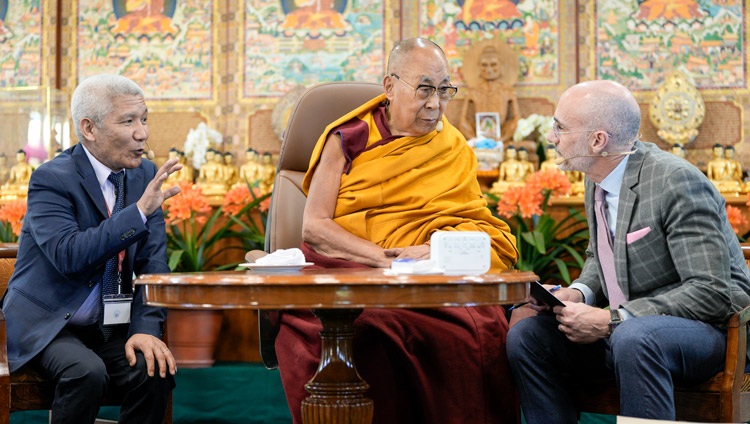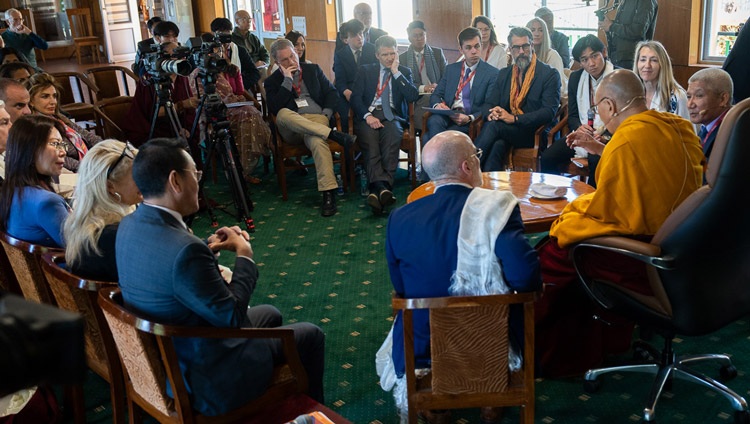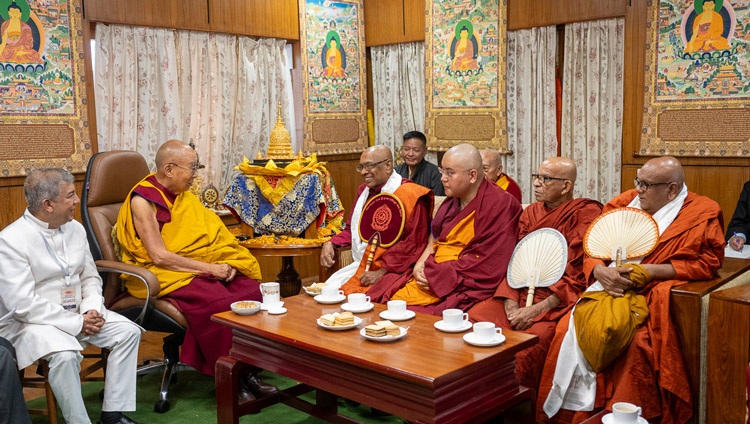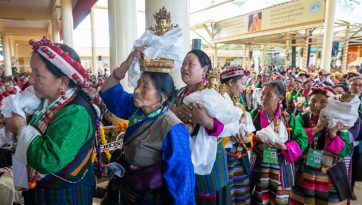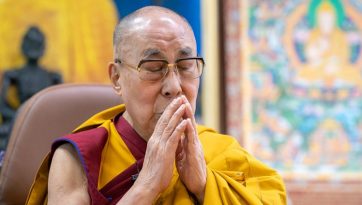Essence of True Eloquence – First Day
October 2, 2020
Thekchen Chöling, Dharamsala, HP, India – This morning, the moment he saw on the screens before him faces of Buddhists gathered to listen to him in Taipei, His Holiness the Dalai Lama smiled and waved. He laughed as he recognized old friends among the ordained and lay members of the audience.
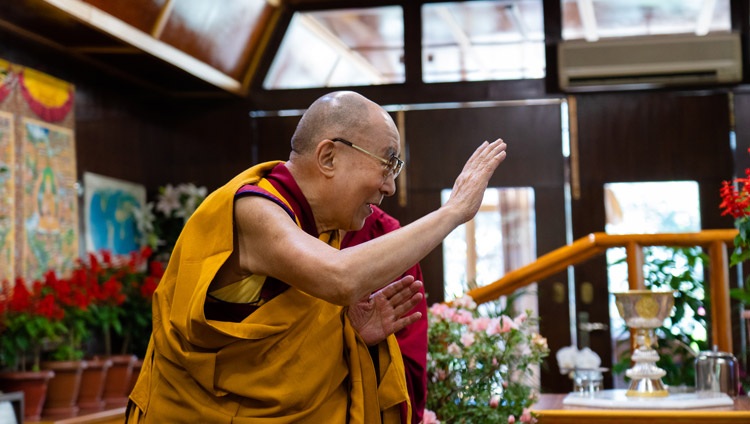
“Today, dharma friends in Taiwan have asked for an explanation of ‘Essence of True Eloquence’,” he announced. “I’ll give a brief teaching.
“The main message of all religious traditions is that it is important to cultivate a warm heart, love and compassion. The practice of non-violence and compassion prevailed in India even before the time of the Buddha. When he appeared, more than 2500 years ago, he took up these practices and made them the basis of his teaching. Followers of theistic traditions attribute what happens to us to the will of god, whereas non-theistic Samkhyas, Jains and Buddhists follow the law of causality.
“After his enlightenment the Buddha is said to have thought —
Profound and peaceful, free from elaboration, uncompounded luminosity —
I have found a nectar-like Dharma.
Yet if I were to teach it, no-one would understand,
So, I shall remain silent here in the forest.
“The words ‘profound and peaceful’ refer the Buddha’s first round of teachings. ‘Free from elaboration’ refers to emptiness as it was revealed in the perfection of wisdom teachings of the second round. ‘Uncompounded luminosity’ refers to Buddha nature, the mind of clear light, explained in the third round.
“Anticipating that no one would understand his explanation of selflessness, the Buddha remained silent for 49 days. When he met his five former companions in Sarnath they requested him to share with them what he’d learned. He taught the four noble truths. He told them that to overcome suffering it’s necessary to eliminate its causes and conditions. The first cause listed in the twelve links of dependent arising is ignorance.
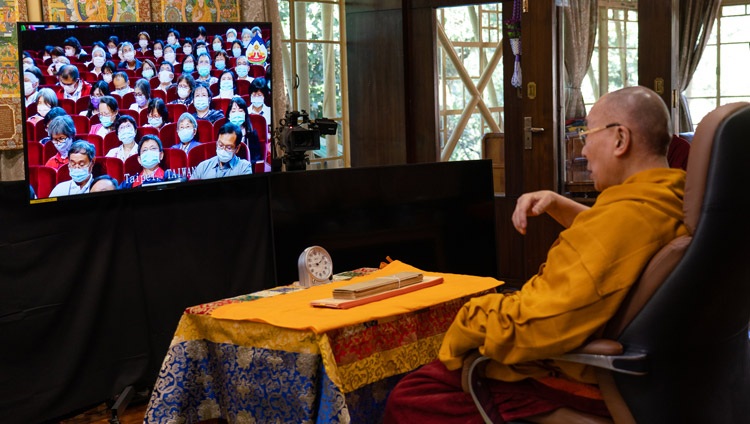
“The masters of Nalanda examined what the Buddha taught. Nagarjuna wrote in his ‘Fundamental Wisdom of the Middle Way’:
Through the elimination of karma and mental afflictions there is liberation.
Karma and mental afflictions come from conceptual thoughts.
These come from mental fabrication.
Fabrication ceases through emptiness.
“We spin in the cycle of existence because of negative karma, negative action, and liberation can only be attained by eliminating by karma and mental afflictions. Nagarjuna’s main disciple Aryadeva confirmed this when he wrote in his ‘400 Verses’:
As the tactile sense [pervades] the body
Ignorance is present in all [mental afflictions].
By overcoming ignorance, you will also
Overcome all mental afflictions.
“Nagarjuna writes that when you understand dependent arising, ignorance does not arise. Ignorance refers to the misconception that things have a true, independent existence. This misconception will not be eliminated by prayer. The only solution is to develop an understanding of dependent arising.
“Nagarjuna confirmed that true cessation is feasible and that it is attained by following the true path. That path includes training in ethical conduct and concentration, both of which are common to non-Buddhist traditions. Wisdom is the third training, but wisdom is of many kinds, wisdom of the five sciences and so forth. What we need is the wisdom to discern whether our various mental afflictions are valid positive states of mind or not. The final, crucial point is that we must apply the teachings to make progress.”
The Buddha advised his disciples to be sceptical: “As the wise test gold by burning, cutting and rubbing it, so, bhikshus, should you accept my words – only after testing them, and not merely out of respect for me.” His Holiness asked, “How do you examine the teaching?” answering that you check it by comparing it with what you know to be evident, with what can be proved by reason.
In the modern era, scientists are not much interested in systems of belief, but they will pay attention to what is presented in terms of reason and logic. His Holiness reported that he has found modern scientists quite prepared to entertain Buddhist explanations of the workings of the mind and emotions because they are grounded in logic and reason, which is characteristic of the Nalanda Tradition. He observed that Chinese Buddhists also revere the Nalanda Tradition and that the Chinese scholar Xuanzang records that he spent time at Nalanda University.
His Holiness mentioned visiting a cave in Central India where Nagarjuna is said to have meditated. Local Indians contend that Xuanzang visited the cave too. He spoke of a conch that he had found nearby and had picked up thinking of it as something auspicious. He asked for it to be brought to him and held it up for all to see. He noted that his Chinese dharma friends hold the Nalanda Tradition and Nagarjuna in high regard and remarked that Nagarjuna’s ‘Fundamental Wisdom’ was translated into Chinese well before it was translated into Tibetan.
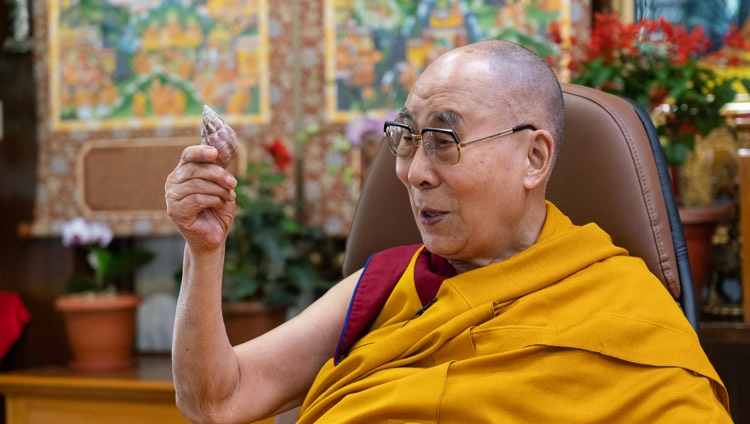
“Songtsen Gampo cemented family links to the T’ang dynasty when he married a Chinese princess.,” His Holiness recalled of seventh century Tibet. “I took my upasaka vow, my novice monk’s vow and my fully ordained monk’s vow in front of the Jowo statue of the Buddha that the princess brought with her from China. It was the principal image in the Lhasa Jokhang.
“Despite his links to China, Songtsen Gampo seems to have found Chinese characters too complicated and chose instead to create a Tibetan script based on the Sanskrit Devanagari alphabet. Similarly, in the eighth century King Trisong Detsen decided to invite Shantarakshita, one of the top scholars of Nalanda University, to Tibet.
“Shantarakshita advised that since Tibetans had their own form of writing they should translate Indian Buddhist literature into Tibetan so as not to have to rely on Pali, Sanskrit and Nepali. This is how we come to have 100 volumes of the Kangyur, the translated words of the Buddha, and more than 200 volumes of subsequent treatises.
“While interest in religion is declining across the world, amongst Buddhists in China, enthusiasm is growing. At the same time, as I said before, some scientists are also intrigued in what Buddhism has to say about the mind, and there are also correspondences between Buddhist thought and quantum theory. Indian physicist Raja Rahmana told me that while quantum physics is regarded as something new, some of its observations were anticipated by Nagarjuna, and he quoted verses to support his view.
“Although quantum physicists don’t apply their understanding to tackle their negative emotions, some academics from Lanzhou University have told me that their understanding has loosened their clinging to the objective existence of phenomena. Perhaps some of you followers of Tenzin Jamchen with links to mainland China can explore this some more.”
His Holiness mentioned that an academic his knows has told him that under changed circumstances, he’d like to invite him to Tsinghua University in Beijing as a professor. He remarked that he would like to convene a conference of Nobel Peace Laureates in China. He expressed admiration for the way traditional Chinese culture has been kept alive in Taiwan.
He noted that masters of all Tibet’s Buddhist traditions have paid special attention to what Nagarjuna wrote. When Jé Tsongkhapa had doubts about the Middle Way View, he contemplated going to India to resolve them with scholars there. However, Manjushri dissuaded him because of threats such a journey would pose to his life. Consequently, he remained in Tibet and thoroughly read all the existing Indian treatises on the Middle Way. Having become learned he went into retreat to apply what he’d understood in meditation and gained insight into the Middle Way view.
“I received an explanation of ‘Essence of True Eloquence’ from Yongzin Ling Rinpoché,” His Holiness declared. “He received it from Choné Geshé Lobsang Gyatso. It seems that the transmission of the text did not exist at that time in Central Tibet, whereas Labrang Tashi Khyil, in Amdo, was a treasury of transmissions.”
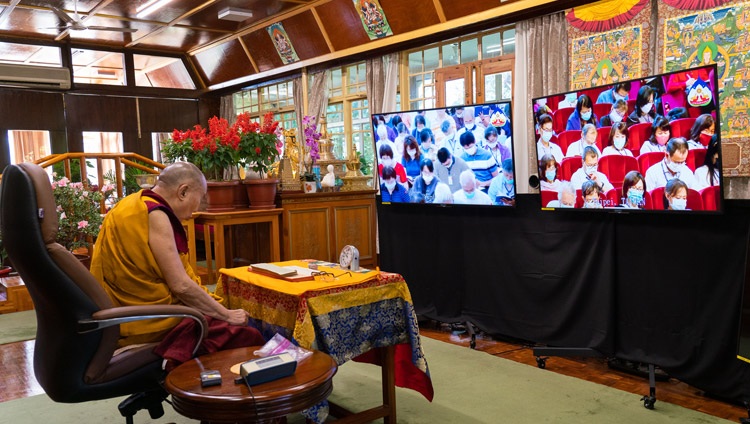
His Holiness began to read from the book, pointing out the significance of the various lines of homage. The mention of several Indian masters prompted him to say that an existing praise to the ‘Six Ornaments and Two Supremes’ omitted to mention a number of important masters. Consequently, His Holiness composed his ‘Praise to the Seventeen Masters of Nalanda’. He noted two sources on the basis of which scriptures were categorized as definitive or in need of interpretation. One was the ‘Unravelling of Thought Sutra’ and the other was the ‘Teaching of Akshayamati Sutra’.
In answering questions from the audience His Holiness clarified that a person is designated on the basis the psycho-physical aggregates. In his first round of teachings, the Buddha spoke of the selflessness of persons, but in the second round, the perfection of wisdom teachings, he also referred to the selflessness of the aggregates and thus the selflessness of phenomena. He confirmed that while the body is forsaken at the time of death, imprints of both positive and negative actions are left on the mindstream and it is this subtle consciousness that continues on to the next life.
He referred to consciousness’s different levels of subtlety, from the relatively coarse waking state to the subtler dream state, deep sleep and the mind at the time of death. Tantra describes how coarser levels of consciousness dissolve into subtler states passing through the visions of whitish appearance, red increase and black near attainment to the mind of clear light.
His Holiness alluded to the state of ‘thukdam’ that some experienced meditators enter into at the time of death. Their breathing stops and their brains stop. They are clinically dead, yet their bodies remain fresh. Yongzin Ling Rinpoché remained in this state for 13 days and recently a Geshé in Taiwan maintained it for 26 days. Modern science has, as yet, no explanation for what is going on. Buddhist science asserts that the meditator’s body remains fresh for as long as his or her subtlest consciousness remains in the body.
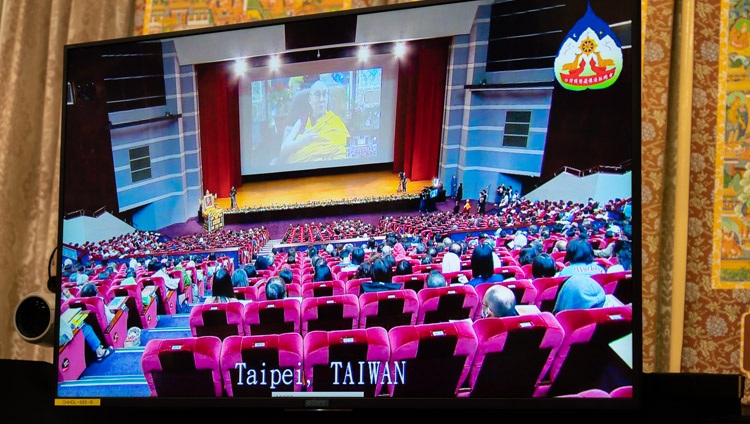
His Holiness advised people who want to know if they are meditating on emptiness correctly to consult three verses from the sixth chapter of Chandrakirti’s ‘Entering into the Middle Way’.
If things depended truly on specific attributes,
Denial of these same attributes would mean things are discounted.
Emptiness would cause phenomena to disappear.
But this does not make sense-which shows that things lack real existence.
Thus, if such phenomena are analysed,
Apart from suchness as their nature, nothing else is found.
And so, the truth of everyday convention
Should not be subjected to analysis.
In absolute analysis, no reasoning admits
Production from another or from self.
And reasoning cannot uphold it even as conventional.
What comes, then, of your theory of production?
He advised that when you emerge from space-like meditation on emptiness, functioning things appear to you, but you see them as illusory and having no objective existence. He noted that Jé Rinpoché stated that dependent arising is appearance, not that what is dependently arisen doesn’t exist.
He stressed the importance of protecting our natural environment, but also of cultivating love and compassion, as well as an understanding of emptiness within yourself. Such practice will lead to meeting with a good life in the future in which to be able to help other beings. He remarked that occasions when you are overwhelmed by anger or attachment are not the time to develop the awakening mind of bodhichitta or an understanding of emptiness. You have to work on that when your mind is relaxed, which will gradually have the effect of reducing instances of giving in to anger or attachment.
His Holiness summarized the explanation of impermanence found in the ‘Stages of the Path’. To begin with, thinking that things will never come to an end we engage in all kinds of unnecessary activity. Gradually we learn that we will die, but that when death will occur is uncertain. What is certain is that at the time of death, only an understanding of the dharma is of any solace.
As the session came to an end, the moderator asked His Holiness if he had anything else to say.
“People create so much trouble for themselves,” he replied, “because they are subject to destructive emotions. None of us, whether we are leaders or ordinary people, want to encounter problems, but we bring them about by giving into anger and so forth. We don’t know how to generate happiness from within. We are ignorant about the causes of happiness. We need to observe a code of emotional hygiene, tackling our destructive emotions as they arise.
“Human intelligence enables us to plan for the future, to see how we show affection for family and friends, but antagonism towards others. It enables us to see how we judge people and things to be absolutely positive or absolutely negative. But these judgements change, reflecting impermanence.”
His Holiness encouraged his listeners to think first about coarse selflessness and to gradually move on to thinking about subtle selflessness. He described making progress stage by stage as we do in ordinary education. He reiterated that to do this is to counter our destructive emotions — and we do this because, essentially, we want to be happy.
SOURCE:https://www.dalailama.com/news/2020/essence-of-true-eloquence-first-day





